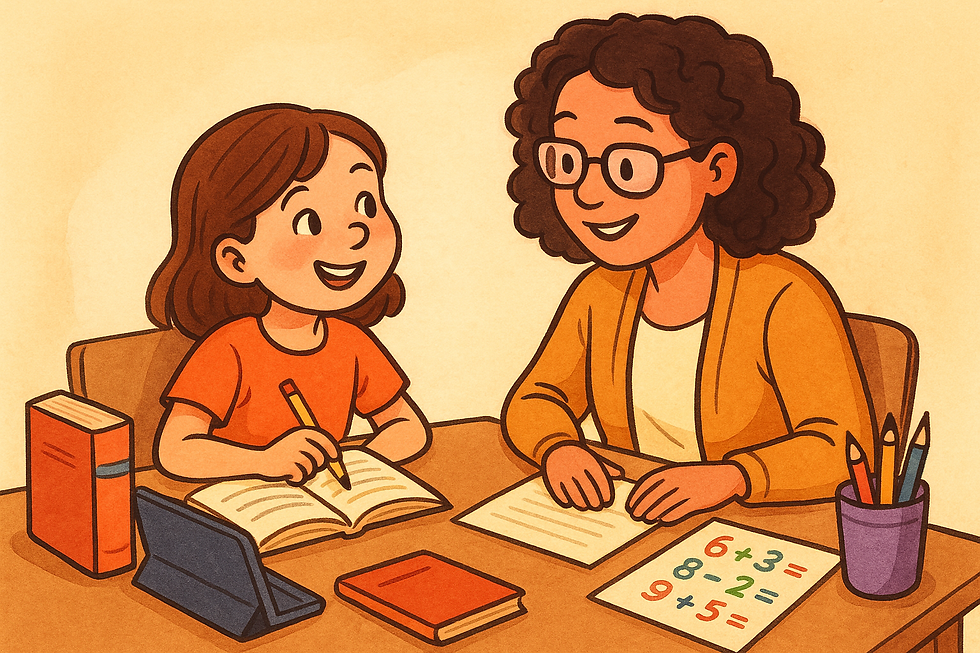Unlock the Fun of Learning Homophones With My In-Person Lessons for Kids
- Simone Dahkoul
- May 21
- 3 min read

Learning a new language can be an exciting adventure, especially when exploring the quirky elements of words. One delightful aspect of language is homophones—words that sound the same but have different meanings. If you're a parent seeking to boost your child's language skills, my in-person lessons create a fun environment to discover homophones while building confidence in English.
What Are Homophones?
Homophones are words that are pronounced the same way but have different meanings and spellings. For example, "bare" (without covering) and "bear" (a large animal) sound identical, yet they convey very different ideas. Engaging with homophones helps children expand their vocabulary, improve reading comprehension, and grasp context better.
In our lessons, we explore various homophones through exciting games and creative activities. For instance, we might read a fun story that includes phrases like "flower" and "flour" to emphasize their meanings. This experiential learning makes lessons memorable and solidifies understanding.
Why Learn Homophones?
Understanding homophones is vital for effective communication. Recognizing context can dramatically shift the meaning of a sentence. For instance, "I can see you" versus "I can sea you" (implying looking at someone versus a body of water) illustrate how homophones can alter perception. Mastering these words helps children express themselves clearly, minimizing misunderstandings in writing and conversation.
Moreover, homophones lay a strong foundation for literacy. Learning to recognize patterns in words boosts spelling and grammar skills. During my lessons, I highlight the role of homophones in common idioms like "to, too, and two" or in phrases such as "peace" and "piece" that show their everyday relevance.
Engaging Activities to Master Homophones
In my tutoring sessions, I embrace fun, interactive activities to help kids learn about homophones. Here are some examples of my approach:
1. Creative Storytelling
I encourage kids to craft their own stories incorporating homophones. This imaginative exercise enhances writing and storytelling skills. For instance, a child might write about a "knight" who has to "knight" someone in a "night" gown. This fun context fosters critical thinking about meaning and usage.
2. Homophone Matching Games
I also play matching games where kids pair homophones with their meanings or corresponding images. This could become a friendly competition where the child who matches the most pairs quickest wins. Such games reinforce learning while making it fun and interactive.
The Joy of Learning Through Fun
Let's face it; if learning feels like a chore, children are far less likely to engage. That's why I create a warm and playful environment in my lessons. When kids enjoy their educational experience, they are more likely to retain information.
Through games, storytelling, and hands-on activities, kids learn about homophones while relishing the process. This positive attitude towards language increases their eagerness to participate and explore more.
Tips for Parents to Enhance Learning at Home
As a parent, you play a vital role in supporting your child's learning journey. Here are a few practical tips to reinforce understanding of homophones at home:
1. Relate Homophones to Everyday Life
Utilize daily activities to identify homophones. For example, while cooking, mention "meat" and discuss "meet." This approach helps your child recognize the relevance of homophones in everyday conversations.
2. Read Together
Reading aloud together exposes your child to different contexts where homophones appear. Discuss any homophones you find during your reading sessions, making it an interactive game. This not only reinforces their learning but makes reading more enjoyable.
3. Encourage Creative Writing
Promote short stories or poems utilizing homophones. This activity bolsters understanding while instilling a sense of achievement. You can implement a “homophone of the week” challenge, where your child chooses their favorite pair to share with the family!
Embracing Fun in Learning
By introducing homophones in a lively and engaging way, we make language learning enjoyable for kids. My lessons aim to provide a supportive space where children can discover the beauty of language, especially homophones.
As your child learns to navigate the nuances of language, their confidence in expression will grow. Involving parents through creative activities, games, and engaging discussions enriches this journey. Learning homophones is not just about memorizing; it's about understanding, enjoying, and expressing oneself clearly.
If you’re interested in personalized tutoring focused on fun language activities, feel free to reach out. Together, we can unlock the joy of learning for your child!

$50
Product Title sample
Product Details goes here with the simple product description and more information can be seen by clicking the see more button. Product Details goes here with the simple product description and more information can be seen by clicking the see more button

$50
Product Title
Product Details goes here with the simple product description and more information can be seen by clicking the see more button. Product Details goes here with the simple product description and more information can be seen by clicking the see more button.



Comments